I imagine the feeling I had must have been similar to that of
parents, having just dropped their kids off at their grandparents for the
week. I loved my bike dearly; in fact, I had a hard time imagining my
life without it, but I suddenly felt tremendously free, almost deviously
free. No more blown tires. No more broken cables. No more grinding up
hills, counting the hours until I hit the downhill. My bike was safely
stored away, left behind in a hotel room in La Paz. I wouldn't see it
again until I was on my way home.
I had ten days. Ten days until I had to catch a flight home, meet a
friend before she headed back to the midwest, then rush over to my
sister's wedding. In those ten days, I wanted to see Bolivia. Not all of
it, of course, but an area known as the Salar de Uyuni, or the Uyuni salt
flats. Everyone told me of the marvels it had to offer; an expansive
plain of salt as far as you could see, high multicolored lakes, and
strange rock formations. No one could put it into words, but everyone
said the same thing; "You have to go." So I did. With so little time
left, biking was out of the question, so I surrendered myself fully to the
traveler's circuit.
The first stop was the mining town of Potosi. Potosi has several
claims to fame. First, it is the highest city (of its size) in the world.
Second, it was the most prolific silver mine in the world, producing
countless riches for the Spanish. As a result, it was an incredibly
wealthy city, but as the silver veins dwindled, so did Potosi's
prominence.
The mines are still in operation, but they produce far more zinc now
than silver. Instead of being run by the state, the mines are now run as
a cooperative, with each mine having exclusive rights to individual veins.
They get to keep whatever they mine. The conditions in the mines,
however, haven't changed since the invention of dynamite. You can still
tour the mines, and doing so is like taking a trip back in time.
Navigating the mines was much more reminiscent of spelunking than of any
mine I've ever seen. Narrow shafts darted off in all directions, and
often you had to crawl to get from one chamber to the next. Every few
dozen meters would be a deep, seemingly bottomless pit in the ground. We
were given old naked-flame headlamps for light, which made it very
difficult to see. And most of the passageways were about four feet high,
forcing mt to crouch the entire time.
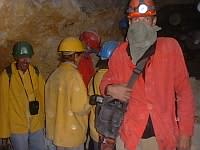 |
Sucking in asbestos fibers
Potosi, Bolivia(6Jun00) |
Miners were busy working while we went through. In order to extract the
ore, they hammer a long metal bit into the rock, then place a piece of
dynamite in the hole and blow it up. They would then use wheelbarrows to
cart out the ore. Miners would constantly be squeezing past us in the
narrow shafts, trying to get onto the next load. In order to make up for
the annoyance we created, we would give gifts of coca leaves, cigarettes,
and condensed milk. They would chew coca almost constantly, to
help give them strength to make it through long hours spent mining.
Oour guide once worked the mines, but moved on to giving tours.
Unfortunately, it had been a little too long since he had been in the
mines,and he soon had us completely lost. He tried to maintain the
impression that he knew where he was, but he would then quietly tell his
"assistant," a boy of about 10, to bribe the miners with coca leaves to
tell us how to get out. As we were wandering, trying to find our way out,
a large explosion went off, and the entire mine shook. Smoke started
filling the passageway, and before we knew what had happened, another
blast went off. Someone was dynamiting right next to us somewhere. We
ran to escape the fumes, but got to a dead end.
Eventually, we had to just hold our breath and push forward back
through the toxic smoke to get back to the right shaft. It's hard to
imagine that the miners live long after being exposed to all those
dynamite fumes, asbestos, and pulverized ore that wafts through the air.
Eventually, after several more redirections from miners, we found the
exit. I unfolded myself from the tiny opening and streched out into the
infinite expanse of clean air and blinding light.
My tight schedule left little room for idling, so as soon as we made it
back into town, I was preparing the next attraction; the Uyuni tour. The
southwest of Bolivia, still part of the altiplano, is vast and sparsely
populated, with only 4x4 roads for access. The only practical way to see
it was part of a tour, and the demand had created quite an industry.
Dozens of companies run nearly identical tours - four days in a 4x4 truck,
with food and accomodation, visiting the Uyuni salt flats, Laguna Colorada
(colored lake,) Laguna Verde (Green Lake,) and various other sights of
interest along the way - all for about US$70. In order to guarantee
myself one day for shopping in La Paz, I needed to start the following
morning, but I hadn't booked anything, and I wouldn't be arriving in Uyuni
until after business hours. So I just picked up the phone, called an
agency at random, and within five minutes, was all setup. They told
me to knock on their office door once the bus from Potosi arrived.
All I had to do was get myself to Uyuni. It was just a simple matter
of a bus trip, which turned out to not be so simple. In order to get to
the bus station, I had to take one of the numerous "combis." Combi is
basically the Bolivian name for a mini-van, bus, or just about any vehicle
that runs and can carry more than a couple passengers. Each one has a
series of names plastered on the windshield, none of which were familiar
to me. After carefully asking someone for the correct combi, and after
specifically telling the driver which bus I was trying to catch, I still
got dropped off at the main bus terminal. According to local sources, my
bus didn't leave from the main terminal, but rather from somewhere about
three blocks down the road. Unfortunately, even after three blocks, I was
told the same thing, that it was about three blocks away. Eventually, one
man I asked offered to take me there, so I followed. After walking a few
blocks down a side street, I started to get suspicious. The man kept
gesturing that it was just ahead, but I was getting a bad feeling, so I
asked the next person I saw where the bus stopped, and he pointed behind
me. I instantly flagged down a taxi, and had him drive me away, all of two
blocks back to where the buses did indeed leave.
The bus ride was uncomfortable, to say the least. My window kept
rattling open, and icy air would pour in, waking me up from whatever
tentative sleep I could catch. Others, obviously seasoned travelers on
the Potosi - Uyuni circuit, brought their own rolls of packing tape with
them, and sealed shut their self-opening windows.
After nine hours, at 4am, the bus finally rolled into Uyuni. 4am is
about the worst time to arrive in a town, because it is too early, cold,
and dark to do anything, but all the hotels are closed up tight for the
night. So imagine my surprise when I was greeted as I got off the bus by
the woman from the tour group, whom I had talked to the previous
afternoon. She took me to the office where, under the glow of a gas
heater, I filled out the paperwork and paid my money for the tour. I was
then escorted to a nearby hotel, where the proprietors had already been
woken up for my arrival. I went straight to my room and straight into
bed.
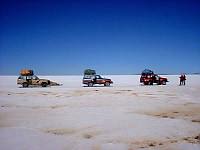 |
Caravan on the salt flats
Salar de Uyuni, Bolivia (7Jun00) |
The weight of the blankets was crushing, but it was still too cold to
venture outside the next morning. I stayed completely submerged under the
blankets until the last possible moment. I had a hard time determining
when that was, as I had apparently ripped the stem out of my watch the
night before unloading my bag, and it was quite some time before I had
noticed and had managed to push the remnants of the stem back in to
restart the watch.
When I arrived at the truck that was to be my home for the next four
days, all of my fellow passengers were waiting for me. There were seven
of us in total, including Catherine, Andy, Claire, and Charlotte from
Britain, Vincent from Italy, and Haley, another American. We also had
Filipe our tour guide and Maria, our very own cook. The first stop was
the salt flats themselves. The remnants of a dry salt lake, the blinding
whiteness of salt continued on as far as the eye could see, until it
blurred into the blue sky at the horizon. The only discernable feature
was the odd hexagonal pattern that had formed on the surface, the result
of the salt crystalizing as it dried from an earlier rain.
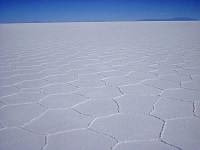 |
Salt as far as you can see
Salar de Uyuni, Bolivia (7Jun00) |
The dried salt, as it turns out, makes for a rather good building
material, and out in the middle of the vast white was a hotel constructed
entirely from salt. Even the tables and chairs were cut from salt slabs.
If that weren't odd enough, in the middle of the dried lake was a rock
"island" - Isla de Pescado, which was covered with cacti!
On our second day, things only got stranger. We visited a number of
smaller salt lakes, which were at such a high altitude (almost 4900m, or
16000 ft.) that they were partially frozen. Living in these lakes were
flocks of flamingos. One of the lakes, Laguna Colorada, was a deep red
color, due to algae, and another was green. All around, the landscape
looked very Martian, with desolate red soil and bizarre rock formations.
I was fully expecting to look up and see marmalade skies appear.
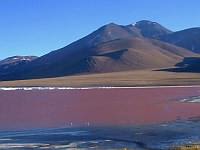 |
Laguna Colorada
Near Uyuni, Bolivia(8Jun00) |
Our nightly accomodations were, well, cozy. Each night, all seven of
us would share a single room, making for lively conversations and fast
friendships. During the days, we had hours on end to talk, and we covered
the whole range, from politics to religion to relationships to the latest
British slang. Being British by blood, it gave me a good chance to update
my vocabulary with such colorful expressions as "The dog's bollocks" (the
best) and to "get on one's tits" (to get annoyed.)
At our furthest point out, on the third day, we were only an hour or so
from Chile. I gave some serious thought to leaving the tour, and working
my way back to La Paz via Chile. This option had the unique advantage
that it would have allowed me to sample "Feeling Black," an ice cream
that, along with Moreno Glacier, was on my friend Janet's list of two
things not to miss in Chile. Once I did the math, however, I realized
that it was going to cost several hundred dollars more; a high price to
pay for an ice cream, but I would hae done it, had it not increased the
chance that I'd miss my flight, and therefore, my sister's wedding.
So instead I decided to stick with my friends on the tour and take the
long drive back to Uyuni.
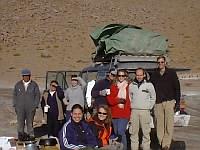 |
The tour group
Near Uyuni, Bolivia(9Jun00) |
An overnight train trip later, and I was back in La Paz. I had about a
day and a half to do all of my gift shopping and take care of all of my
errands before beginning the long trek home. Bike touring had been a
convenient excuse to not bother buying anything, since I didn't want to
carry it, but since I was on my way home, all bets were off. La Paz is an
amazing place to shop. While carrying the usual fare of weavings,
clothing, pottery, etc. it was also an excellent source for those hard to
find items like llama fetuses and llama toenail marimbas. Having had
already received the llama toenails as a previous gift, I was all ready to
get a llama fetus to reciprocate. But not knowing what one would use one
for in western society (Peruvians use them as a sacrifice for new
buildings) it seemed like a waste of a perfectly good llama fetus.
Anyway, I'm sure it wouldn't be easy to get through customs.
My shopping binge over, it was time to begin my marathon haul back
home. It was a grueling lineup with little room for error: an evening
bus to Desaguadero, a morning bus to Puno, another bus to Juliaca, then an
afternoon flight to Lima, an evening flight to Mexico City, a connecting
flight to LA, and finally, a flight back to San Francisco.
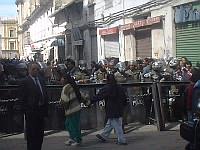 |
Riots in La Paz
La Paz, Bolivia(12Jun00) |
Things started off rocky from the word go. In fine South American
tradition, there had been protests and strikes that day,so it never was
clear if there would be any buses at all. All the tourist agents said
that there were no evening buses, but I had heard that there were local
buses running all the time, so I just headed up to the "cemetary district"
where the buses supposedly departed from. I was hoping the drivers worked
the graveyard shift. By this point, I had an entire entourage with me:
my front panniers, my back panniers connected together as a backpack, my
camera gear, varios bags full of books and ceramics that I had bought as
gifts, and, of course, my bike, wrapped up tightly in a box that I had
found in town earlier. The next bus to Desaguadero didn't leave for three
and a half hours, but there was a bus to Copacabana that left within an
hour. All I needed to do was get close to the border, so that I could
cross it as soon as the border station opened in the morning.
The bus didn't leave when it said it would, of course, but instead stood
parked for a good two hours. We finally got rolling about 10pm. That
would put me in Copacabana about 1am, which was later than I had hoped, but
still left time for some decent sleep. The bus was freezing, but I figured
I could endure it for three hours. Unfortunately, I had forgotten about
the short section of lake we had to ferry across, and no one had mentioned
that possibility that the ferries wouldn't operate at night. So at
midnight, on the northern shore of Lake Titicaca, the bus pulled into a
line of waiting vehicles, and turned off the engine for the night.
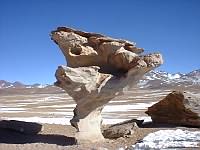 |
The Tree of Rock
Near Uyuni, Bolivia(8Jun00) |
The cold air in the bus was biting, and everyone else on board was
buried underneath a pile of thick alpaca blankets. My sleeping bag was
packed away in my bike box, which was locked in a storage compartment
under the bus. There was no way I was going to get a wink of sleep
without it, so I pounded on the driver's door to get the key to the
storage compartment. He eventually appeared, only to mumble something
about the key being over the tire. I had no idea what he was talking
about, so I went outside and tried to see if the compartment was already
unlocked. It wasn't. My mind frantically weighed the options; go back
to an already disgruntled driver and make him unlock it, try to work over
one of the old ladies on the bus and steal her blankets, or use brute
force to get my sleeping bag. I chose the latter. Already pissed off by
the fact that I was going to have to spend a freezing night on the bus, I
had ample adrenelin coursing through me. With one sharp pull, I ripped
the latch off the door, and swung it wide open. I yanked my bike out,
tore open the box, and snatched out my sleeping bag. I then tossed the
box back in the bus, and tried to latch the door shut as best I could. By
this point, I had drawn the attention of everyone on my side of the bus,
including one individual, who was sitting above the rear tire, who seemed
especially concerned. He apparently was the keeper of the key, and as I
headed back to my seat, he grudgingly trudged outside in an attempt to
undo the damage I had done.
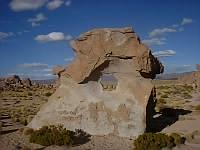 |
Strange rocks
Near Uyuni, Bolivia(9Jun00) |
I was awoken at 5:15 in the morning by a group of women who were
merrily blabbing away. Apparently Peruvians wake up early. 45
excruciating minutes later, we were all escorted off the bus, where we had
to stand out in the cold and wait for the boat to take us across the
straight. The boat could only take a dozen people at a time, so it was 45
minutes before I was on my way across. The bus arrived a half hour after
that, and we all piled back on for the final stretch to Copacabana.
We arrived in Copacabana at 8am, just in time for me to catch a combi
to the border. The combi wouldn't actually cross the border, so I had to
carry everything by hand 300ft across the border to the Peruvian customs
office. As I was walking across with my bike, the customs officer at the
border, thinking that I was importing a new bike, wanted me to pay tax on
it. A quick peek inside quickly cleared him of that misconception.
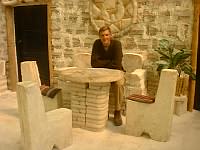 |
The Salt Hotel
Salar de Uyuni, Bolivia(7Jun00) |
The next few segments of my trip went fairly smoothly, and by 9pm that
evening I was in the Lima airport. I had brought my ticket home when I
was last in Lima, but they didn't have my ticket ready before I left, so I
instructed the travel agent to leave it at the hotel I had stayed in when
I was there. I had left careful instructions with the hotel that someone
would be dropping off a ticket for me, and a few hours before my return to
Lima, I had called both the travel agent and the hotel to ensure that my
ticket would be waiting for me. My flight left at midnight, so I barely
had enough time to take a taxi into town, recover the ticket, and return.
Continuing the theme of my hellish dash home, the ticket wasn't there.
There was, however, a message. The agency had long since closed for the
day, so I was given the agent's home phone number. After screaming her
ear off for a few minutes, she assured me that she would send someone
right over with the ticket. With no other option, I sat in the taxi and
waited, watching the minutes until my departure tick by. Miraculously, my
ticket arrived within half an hour, and we were soon speeding off to the
airport. Taxi drivers are notoriously crazy in Lima, but my driver took
crazy to a whole new level. We raced through red lights, went the wrong
way down one way streets, and weaved between lanes, getting back to Lima
airport in about half the time it took on the way out and even with a few
minutes to spare. I left a big tip, partially to thank the driver, and
partially as an offering to the traffic gods in appreciation for our not
getting killed.
A long nap later, and I was in LA. So close; but still so far. While
standing in line at LAX, a couple noticed my bike box and started asking
me about the trip. "What was the hardest part of the trip," they asked.
I jokingly replied that the hardest part was always getting from LA to SF.
They laughed, but I wasn't far off.
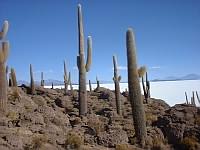 |
Isla Pescado
Salar de Uyuni, Bolivia(7Jun00) |
First, I had to do my now well rehersed argument when they wanted to
charge me $40 to check my bike. The whole ticket only cost me $60, and I
could have brought any number of skiis, snowboards, or golf clubs, at no
charge. I had decided to fly to Oakland so I could avoid flying United
Airlines, since they have overcharged me so many times before, but
apparently Southwest is no better. Then, upon arriving in Oakland, they
lost my baggage. I've flown all over the world with my bike and never had
any problems, but every time I fly within the US, they lose something.
Fortunately, they lost the heaviest bag, so it made carrying everything
easier. After discovering that my ride home had fallen through, I lugged
everything over to the BART (local transit) station, for the trip to the
other side of the Bay. I then shlepped everything up to the curb so I
could get a taxi home. But I had forgotten how bad taxi service in San
Francisco is. I had been spoiled by being in countries where the taxi
drivers actually want your business, where they will go out of their way
to help you, no matter what you're lugging around.
I sat on the curb for 45 minutes, only getting two taxis to stop,
neither of which were interested in taking me. So finally I decided to
screw them, and proceeded to load up my body with my panniers, my camera,
and two bags full of breakable ceramics. I then balanced my bike box on
my head, and slowly waddled the seven blocks uphill to my house. Like it
or not, I was home. As I slowly unpacked my bags, I noticed two large
bags of coca leaves, which I had bought way back in Peru,
still in the outside pouch of my panniers where I had left them. Maybe it
wouldn't have been so hard to get that llama fetus through customs after all.

